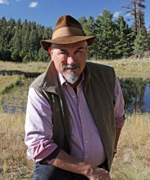 —Alan Dulaney
—Alan Dulaney
It is difficult to face the challenges of one century with the tools of the last. In June, the Kyl Center of the Morrison Institute at Arizona State University announced a new tool that should aid considerably in approaching the issues that a warmer and drier Arizona now must deal.
The Arizona Water Blueprint is an interactive map-based compendium of water information across the state. Built in ArcGIS, multiple layers cover hydrography, political and regulatory extents, infrastructure, habitat, and augmentation possibilities. Data is derived from several sources, but the Arizona Department of Water Resources (ADWR) looks to have been a major source. The US Fish and Wildlife Service provided data for critical habitat definitions, and the State Land Department (with ADWR) contributed to the augmentation section. CAP and SRP contributed infrastructure information, along with other jurisdictions. You can visit the Kyl Center website to start using the Water Blueprint. This is definitely worth looking into.
Arizona is blessed with multiple agencies that make the data they collect and store available for projects such as the Water Blueprint. ADWR in particular is a gold mine of information on surface and groundwater, wells, regulatory matters, and augmentation. The difficulty has always been how to get this information out to the public, especially those who have concerns about water issues, but don’t know where to start. ADWR genuinely welcomes this effort to present information to the lay public in an intelligible manner.
One of the most interesting features of the Water Blueprint is the concept of a water story map. Consisting of images attached to the spatial data, water story maps convey essential information on specific topics of water resources to the reader. Several story maps already exist within the Arizona Water Blueprint, including one on rural water issues by county, water augmentation concepts, and adjudications. More can be created. These story maps provide a great opportunity to educate the public, a public which is increasingly interested in water issues as they hear terms like “megadrought.” By constructing this tool, the Kyl Center has performed an important service for the state and its people.